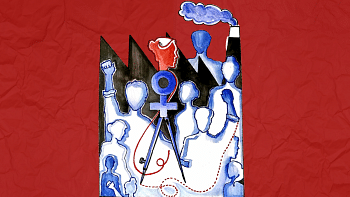Save us from the saviours

Though women's "empowerment" is an indicator for development, it's at risk of losing its transformative edge. Globally, empowerment has been framed as a doable, reachable, and measurable goal; yet, it is highly context-specific, fluid, and messy. When we see the nature of many empowerment projects (set up by Western donor agencies), we can track it back to the era of Western colonialism, when women became a prime focus of "civilising" projects. Education for girls and women sought to produce domesticated "good women" who would maintain hygienic homes and respect their husbands (Hunt, 1990); the contradictions of colonial extraction also fostered "bad women" who were forced to leave rural homes for the lives of sex workers in the city.
When colonialism redrew the boundary between moral and immoral, it was mostly women who were targeted for the "saviour projects," under the banner of "social reforms." The irony is that colonialism left behind its material, discursive, and policy formulation legacies, which the once-colonised nations still follow. The construction of gender and gender equality in contemporary South Asia has been shaped in distinctive ways by historical processes of colonialism.
Colonial social reforms for women were always a highly charged political affair. The reforms brought some positive changes, but benign neglect has typically been the norm. The feminist historian Lata Mani demonstrates women were neither the subjects nor the objects in the debates about abolishing various traditional practices; they were merely the grounds on which the meaning of "tradition" was debated. The point that colonial debates on social reforms were often less about women per se and more about the nature of indigenous culture or tradition has resonated widely in the context of many different cases (such as how the Devadasi were categorised as sexually immoral beings and, consequently, lost their land rights). The Hindu Widow's Re-marriage Act, 1856 was enacted to liberalise the condition of upper-caste Hindu widows who could remarry under the provisions of the law. The Act, with more ambivalent results, brought under its ambit women from subordinate castes who had not previously suffered similar restrictions against remarriage. The women of subordinate castes who could remarry previously without any penalty were newly subject under the provisions of the Act, which included a compromise that restricted the property rights of the remarried widow to its restrictive inheritance regulations (Carroll, 1983).
Global economic power might be starting to shift, but the power to name, represent, and theorise is still located in the "West." In the third world nations, we see a version of "modernity," "progress," and "equality/empowerment" whose standards are set by the West. According to the United Nations Population Information Network, women's empowerment comprises five components: women's sense of self-worth; their right to have choices; their right to have access to opportunities and resources; their right to have power to control their own lives; and their ability to influence the course of social change to create a more just social and economic order. In this new rhetoric of women's empowerment, the "third world woman" was conceptualised as an autonomous and sovereign subject who freely made rational choices in the market. She was thrifty, hard-working, entrepreneurial, and a good manager of resources. She controlled her reproductive body, kept her family small, and exercised her right to vote. However, at an epistemological level, there was no discussion of what it meant to frame development programmes and policies in terms of an autonomous female subject. This imagined "third world woman" did not bear any resemblance to the rural woman in whose name she was deployed. This idea and image were so celebrated in development seminars and Western media that the imagined woman was substituted for the woman on the ground. That is, the idea became more real than the real itself, or what Ramos termed a "hyperreal woman," and development organisations and NGOs were at the forefront of translating the women's empowerment mandate into practice.
In the post-1970s environment of neoliberal development policies, the NGO emerged as a hybrid institution that took over many of the functions traditionally reserved for the state. In particular, NGOs have targeted the "third world woman" as key to social transformation, a global mandate to integrate women in all aspects of development work. In doing so, many such organisations followed the footsteps of the West, which created an obsession of "50 percentism," which was set as a parameter for equality, empowerment, and development. While this 50 percentism is a valid criterion in cases of sex ratio, health, and nutritional needs, it does not tell the whole story in other domains and can instead lead to erroneous conclusions. An example is the excitement over equal participation of women in parliaments. When political parties are themselves under the grip of money, muscle power, and corruption, and when there is lack of accountability and transparency, can the presence of a certain percentage of women make our polity more citizen-friendly?
South Asian NGOs are unique in their vanguard position in the global NGO landscape. India, the world's largest democracy, has a mind-boggling 3.3 million NGOs which include developmental NGOs, community organisations (COs), and grassroots organisations (GOs). Bangladesh has over 20,000 registered voluntary organisations and 2,137 registered NGOs which work directly with foreign funds. As early as 1996, the World Bank had termed the Bangladeshi NGOs as "some of the most effective agents for change in the 21st century."
As long as NGOs increased the number of women members in their programmes, the funds flowed in from donor agencies for these women's empowerment activities. It is equally important to note that these ideas are rooted in the Western historical experience, although they are "employed as if their meanings were universal and unequivocal" (Mercer 2002). Many critics suggested women must engage in development policy decision-making themselves in order to move beyond the "project trap" of donors. This has resulted in the participatory development model that encourages women to discuss their needs with NGO workers. The downside to this approach is that it still keeps women within a framework of development priorities (that is, as a welfare investment project) and does not intervene in the local power dynamics which ultimately sustain and reproduce gender and social inequalities.
It is indeed true that, in Bangladesh, NGOs have wrought many positive changes. Today, women are far more visible in rural areas due to the heavy presence of NGOs. But it is important to underscore that the subaltern status of many women remains unchanged.
Three decades have passed since Gayatri Chakravorty Spivak wrote Can the Subaltern Speak? wherein, through the famous line, "White men saving brown women from brown men," she elaborated how deeply colonisation had seeped into our system, and how we are still carrying that baggage, and it reflects in our work, belief, and practices, even in the development sector. In the end, I believe (as a woman), more than saving, we need a voice -- our voice -- to tell our own stories; stories of struggle, victory, and of defeat as well.
No amount of writing will ever be enough to interpret this truth, to theorise it, to articulate it. But spotting these patterns can be the first step towards breaking away from this cycle. This is my hope for International Women's Day, where we not only represent each other, but give voice to each other and create space for each other instead of following in the footsteps of our colonisers.
S Arzooman Chowdhury is MPhil candidate at the University of Cambridge.
Views expressed in this article are the author's own.
Follow The Daily Star Opinion on Facebook for the latest opinions, commentaries and analyses by experts and professionals. To contribute your article or letter to The Daily Star Opinion, see our guidelines for submission.


 For all latest news, follow The Daily Star's Google News channel.
For all latest news, follow The Daily Star's Google News channel. 











Comments